Are you tired of struggling to reach items in the depths of your kitchen cabinets? Blind corner cabinets can be a challenge for even the most organized homeowner. But fear not—we’re here to offer some innovative ideas for making the most of those tricky dead corners in your kitchen.
In this blog post, we’ll explore creative solutions and design hacks to help you maximize storage and accessibility in your blind corner cabinets. With these clever ideas, say goodbye to wasted space and hello to a more functional kitchen!
What is a Blind Corner Cabinet?
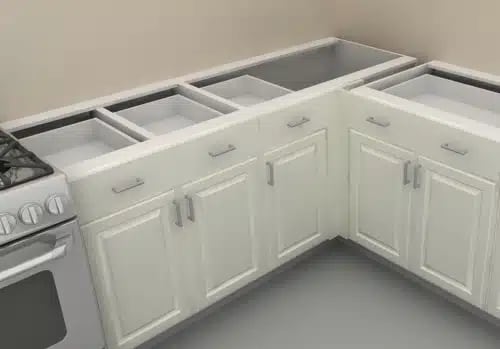
A blind corner in a kitchen refers to the hard-to-reach space created where two sets of cabinets meet at a 90-degree angle. This makes it challenging to access items stored in that area, often leading to wasted storage space and frustration for homeowners trying to utilize these corners effectively.
A blind kitchen corner cabinet helps save this space and provides extra room for storage.
It is a changed 36” base cabinet that features 18” double doors, while a blind base corner will use a 15” door and a center stile. A center stile is the wood piece next to the door that acts as a spacer for the cabinet that connects to the cabinets to the side, making it the blind part of the cabinet.
Mechanics and Specifications of Blind Corners
A blind corner cabinet is exactly like a regular 36” cabinet. It commonly features one functional drawer and one door. Half of the cabinet is hidden in the corner, but the space is still usable.
Many people will use a blind corner cabinet to store baking trays, pots & pans, or even large appliances not commonly used. A blind corner will also have an option shelf inside to double storage inside. This shelf is removable for additions one wants to add later on.
For an even more efficient use of corner space, consider installing custom corner drawers like those from @golancustommade. These drawers are uniquely shaped and perfect for storing smaller items such as spices and kitchen utensils.
Some space needs to be used to pull the cabinet out. These cabinets are pulled out 6 inches from the wall rather than sitting flush against both walls. A filler is typically used to space 3” from the center stile of the blind corner cabinet to the next cabinet. The filler acts to put in enough space for the door handles to open fully without colliding with other handles or doors.
Why do you need a Blind Corner Kitchen Cabinet? Mechanics of Blind Kitchen Cabinets

Smaller kitchens that want to have a Lazy Susan are forced to fill in space.
This means small cabinets and even downgrading other cabinets are needed to put in the Lazy Susan. Many people do not like the idea of having to put in a spice rack or even a 12” base cabinet. While one theoretically sacrifices 6” of space to fill that space with the blind corner cabinet, they enable the reset of the kitchen cabinets to be what they want. Additionally, the blind corner cabinet typically has a larger diameter, allowing for more storage space and making it a crucial component for maximizing kitchen space.
The second advantage is the final cost. A kitchen remodel cost can surprise one after all the cabinets they want end up much higher than ever anticipated. Lazy Susan cabinets are the second most expensive cabinet to pantry cabinets.
The number of resources used to assemble a Lazy Susan is almost twice that of a normal cabinet. Like a regular base cabinet, a blind corner cabinet is half the cost of the Lazy Susan, making it a budget-friendly option for those looking to DIY their kitchen remodel. This gives the homeowner more room to plan other necessities of the remodel.
Also Read: How to Measure Kitchen Cabinets Like a Pro
What are the Common Mistakes with Blind Corner Cabinet?
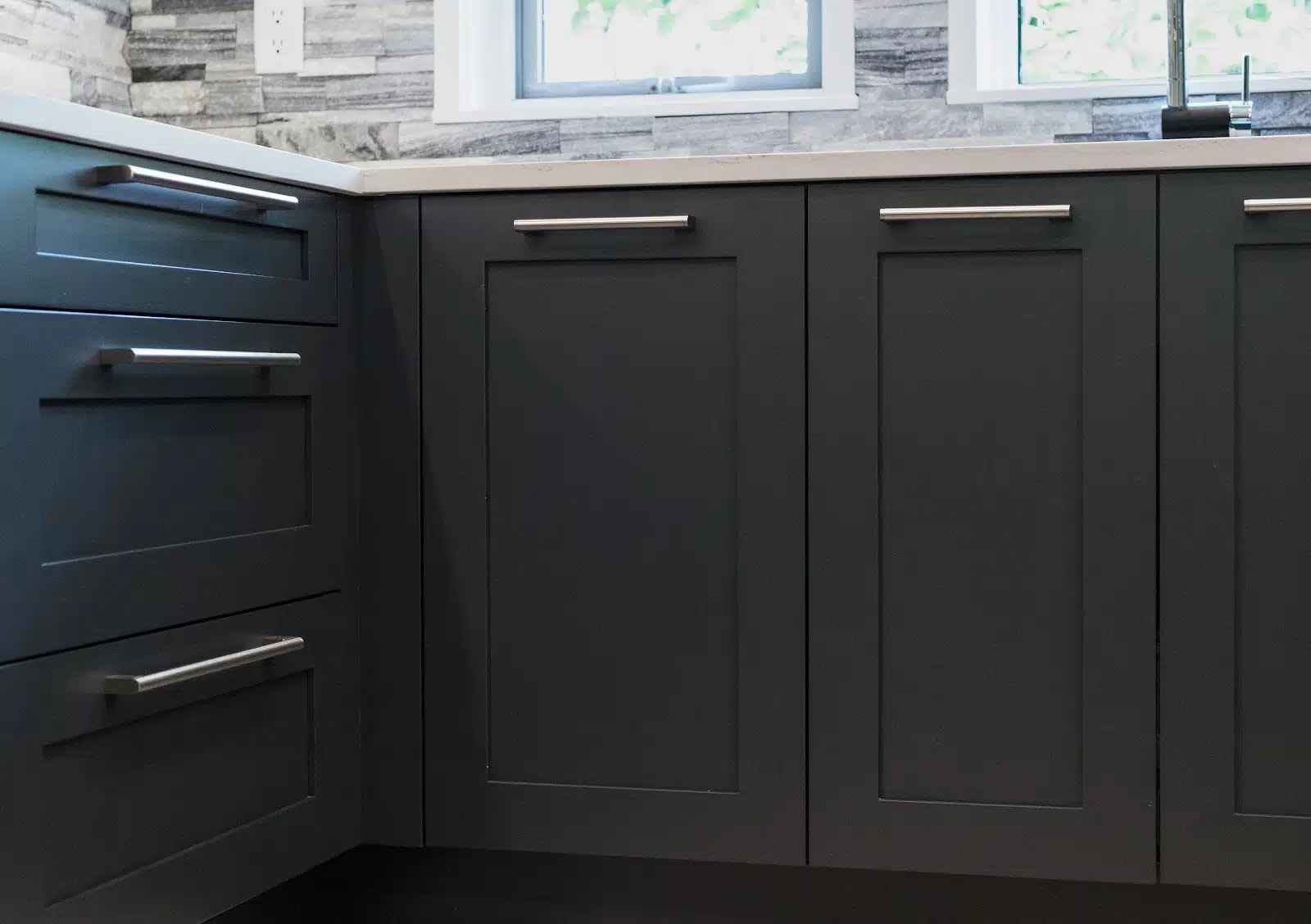
There are things that can go wrong with the blind corner cabinet. Of all cabinets, blind corners must follow two rules that other cabinets do not have to worry about.
Professional cabinet installers are aware of this, but individuals installing themselves need to be aware. A kitchen designer will always be mindful of the potential for colliding and interfering door handles. The base cabinet MUST be pulled out 6”, and a 3” filler must be used to space the cabinet from the center stile.
Not pulling the cabinet out 6” will result in the door and drawer not opening properly. Particularly, the drawer needs room to pull out. It won’t hit any perpendicular door handles. Similarly, the 3” filler must be added to allow the door to swing fully without colliding with any obstacles. This filler also allows drawers on the perpendicular side to open.
Also Read: White Kitchen Cabinet Combinations
Blind Corner Cabinet Ideas for Base Cabinets
When dealing with blind corner kitchen cabinets for base cabinets, exploring creative solutions is key to optimizing storage and accessibility. Cabinet companies have introduced various innovative designs to make the most of this challenging space.
From pull-out shelves to revolving trays and swing-out baskets, these options provide efficient ways to access and utilize the contents of your blind corner cabinet. By incorporating these smart storage solutions, including a pull-out swivel motion, you can ensure that no space in your kitchen goes to waste, even in those hard-to-reach corners where traditional shelving might fall short.
Lazy Susan Cabinets

Blind corner cabinets pose a unique challenge in kitchen design, requiring careful attention to detail to ensure optimal functionality. Pulling out the cabinet 6 inches and using a 3-inch filler made of plywood is crucial to allow for proper door and drawer operation, preventing any obstructions with handles or adjacent appliances. Communication with the designer about appliance choices is essential for customizing solutions around specific handle placements.
The use of smart designs such as Lazy Susan cabinets can significantly increase the usability of blind corner cabinets. By incorporating a Lazy Susan mechanism, you can ensure easy access to items stored deep within the cabinet without the need to rummage or struggle. This rotating platform, also known as a glide, maximizes storage efficiency and minimizes the chances of items getting lost in the back corners.
Corner Drawers
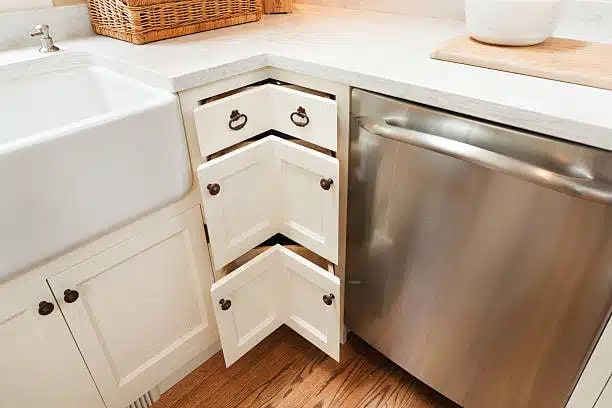
Corner drawers are another innovative solution to maximize the storage potential of blind corner cabinets. By incorporating custom-designed corner drawers, you can effectively utilize all available space while maintaining easy access to your kitchen essentials. These drawers can be tailored to fit specific dimensions and provide a practical alternative to traditional shelving units.
With their unique design, corner drawers offer a seamless and organized storage solution that eliminates the need to reach deep into dark corners. This option not only enhances the functionality of your kitchen but also adds a touch of elegance and sophistication to the overall design aesthetic.
Moreover, sliding baskets or wire racks are excellent additions to blind corner cabinets, creating accessible and visible storage options for pots, pans, and other kitchen necessities. These accessories enhance the usability of the cabinet, making it easier to keep track of items and maintain a clutter-free environment.
The Corner Pantry
Transforming a blind corner cabinet into a corner pantry is a brilliant way to optimize storage space while adding a touch of luxury to your kitchen. With custom shelving units, pull-out racks, and adjustable shelves, you can create an efficient pantry that keeps your ingredients and cookware neatly organized and easily accessible.
By using the full height and depth of the cabinet, you can store a wide range of items, from canned goods to small appliances, in an orderly fashion.
Also Read: What is a Shaker Style Kitchen Cabinet?
Blind Corner Cabinet Ideas for Upper Cabinets
For upper blind corner cabinets, consider installing pull-out shelves or swing-out organizers for efficient kitchen storage. These solutions bring items to the forefront, making it easier to reach and organize your kitchen essentials without straining or struggling. With adjustable shelving heights, you can customize the space to accommodate varying item sizes while maximizing storage efficiency.
Diagonal Cabinets
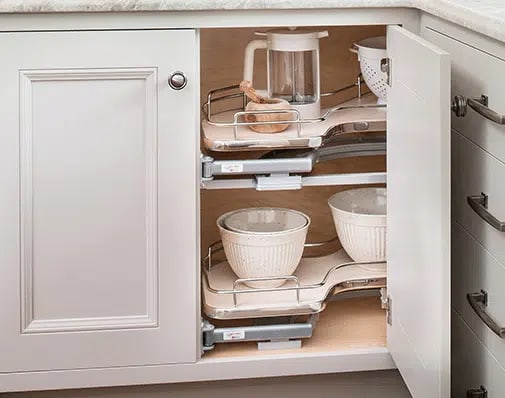
Diagonal cabinets are a unique and practical option for optimizing blind corner spaces in your kitchen layout. By incorporating diagonal cabinets, you can effectively utilize the often-underutilized area in corners while maintaining a cohesive design aesthetic. These cabinets feature shelves or pull-out trays that extend into the corner, providing easy access to items stored within, making them a great addition to any cabinetry design.
Their angled design offers a seamless blend of functionality and style, adding an interesting architectural element to your kitchen layout.
Countertop Cabinets on one wall only
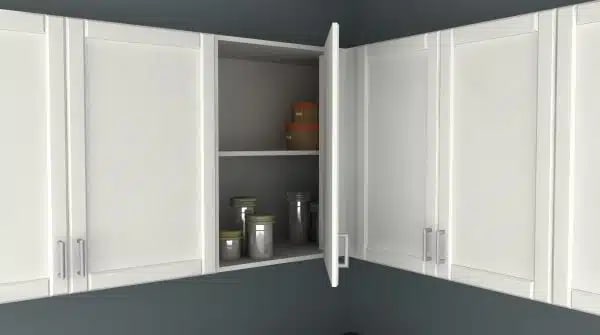
Countertop cabinets on one wall only can create a focal point in your kitchen, offering a balance between storage and open space. This design choice can enhance the visual appeal of your kitchen by creating a streamlined and minimalist look. By opting for cabinets on only one wall, you can maximize natural light and create an airy atmosphere with the use of materials and finishes such as chrome, gray, white, almond, orion gray, and natural wood.
You can consider incorporating glass-front cabinets or open shelving to showcase decorative items or dinnerware, adding a touch of personal style to your kitchen space.
Also Read: Affordable kitchen cabinets and when to buy
Effective Ways for Blind Cabinet Organization
Organizing a blind corner cabinet can be challenging, but with the right tools and techniques, it can become a functional and efficient storage space in your kitchen. Here are some effective ways to organize your blind corner cabinet:
Use Pan Right Organizers
One clever way to make the most of a blind corner cabinet is by utilizing pan organizers to store items upright. This not only maximizes storage space but also makes it easier to access pots, pans, and lids without having to dig through a cluttered cabinet. By keeping your pans organized and upright, you can create a tidy and efficient storage solution for your kitchen essentials. This method was even featured in a comment from Lorie last week, who found it to be a successful solution for her 60’s era blind corner cabinet.
Pan organizers come in various sizes and styles to fit different cabinet dimensions, making them a versatile solution for making the most out of your blind corner cabinet space.
Sliding Drawers for organization
Sliding drawers are another effective way to organize a blind corner cabinet. These drawers can be installed on multiple levels within the cabinet, allowing you to easily pull them out and access items stored in the back without having to reach or strain your back. Sliding drawers not only maximize storage space but also provide a clear view of all your items, making it easier to stay organized and efficient in the kitchen.
Pairing sliding drawers with pull-out shelves or baskets can further enhance the accessibility of your blind corner cabinet, ensuring that every inch of space is utilized effectively.
Conclusion
When it comes to blind corner cabinets in your kitchen, creative solutions can turn these tricky spaces into functional and accessible storage areas. From pull-out shelves to rotating carousels, there are various ways to make the most out of your blind corners. By optimizing these storage solutions, you can maximize space efficiency and convenience in your kitchen.
Frequently Asked Questions
Is a Blind Corner or Lazy Susan better?
Ans: It depends on your specific needs and preferences. Blind corners and lazy Susans both have their pros and cons. A blind corner cabinet typically has one door covering the entire opening, making it harder to access items in the back. On the other hand, a lazy Susan is a rotating shelf that allows for easier access to items in the back of the cabinet.
What can I do with blind corner cabinets?
Ans: Blind corner cabinets are versatile and can store a variety of items such as pots, pans, containers, and spice jars. They can also be used as a pantry or a rotary recycling center.
What are the main functionality of Blind corner kitchen cabinets?
Ans: Blind corner kitchen cabinets are designed to maximize storage in hard-to-reach corner areas. They offer functionality by utilizing pull-out shelves, sliding drawers, rotating carousels, and other innovative solutions to make the most out of the space. These cabinets provide efficient storage for pots, pans, containers, spice jars, and pantry items and even serve as rotary recycling centres. By incorporating creative ideas and organizational tools, blind corner cabinets can transform into accessible and practical storage units in your kitchen.




